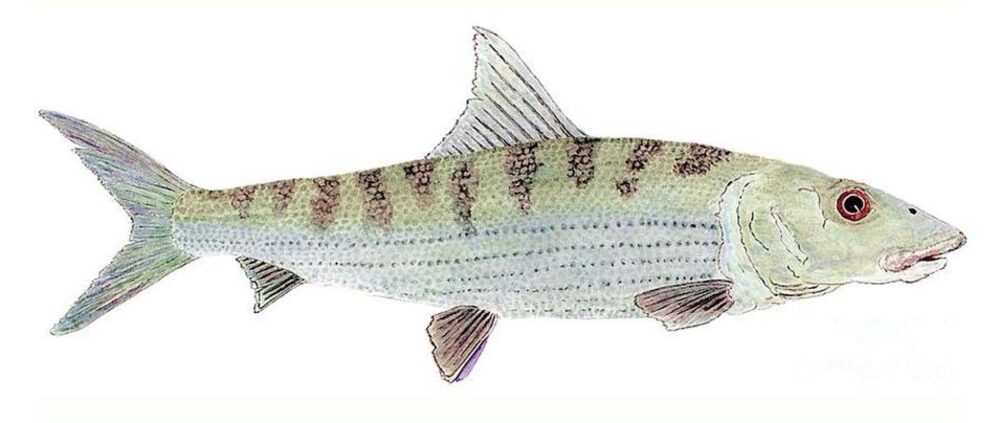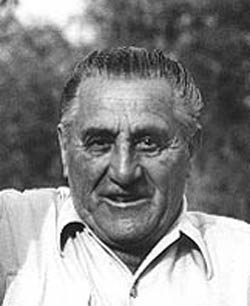
Albula Vulpes. Bonefish illustration by Thom Glace. . .
Too many punches to the head
By Skip Clement
We’ve all been down this road, whacking ourselves in the head and back with a fly when it’s windy – especially when using weighted flies. Slow to learn, I finally decided enough was enough. One day, more than a decade ago, while fly fishing for bones in Islamorada, Florida. A lead eye Charlie attacked me from behind and left a residual knot the size of a marble on my thick, Irish skull. I realized then that it’s always going to be windy in the Keys, South Florida, and the Bahamas, especially in the winter, and that heavy flies were a part of the game that I loved and that there had to be a better way to cast them without suffering from combat fatigue. We all learned to modify our casts to avoid injuring ourselves, but I knew my modification wasn’t the answer.

Permit illustration by award-winning watercolorist Thom Glace. Visit his site here . .
Better than me
I called Andy Caldwell, a friend who’d beaten me to retirement by a dozen years. We’d met in Ketchum, Idaho, in 1991. He and I loved discussing fly fishing, tying flies, environmental issues, and unique destinations.
We fished that spring after ice-out, all summer, and into fall almost daily. Then, we began monthly long-distance conversations until he passed away a few years ago. I still miss him.
Andy and I were never equals. Andy taught me how to “properly” fly cast, tie flies, swim them like bait, and catch fish. He was always better than me.
Once he retired, Andy became a professional guide and casting instructor. He spent his summers in Montana in a campervan parked behind a fly shop he part-timed at and wintered in the Abacos, Bahamas, where he had a small studio apartment in Marsh Harbour. Andy had a Bahamian-built wooden skiff in its 50th year [it was a striking image of a Willy Roberts] powered by a new 40HP 2-stroke. The marina where he kept the boat was just a few blocks from his apartment. The skiff was immaculate, sturdy, and required a lot of grooming.
Andy had a steady flow of hand-chosen clients who visited him in the Bahamas. He had to know you and like you, and you had to be a good caster and angler. Bribes to get on his boat didn’t work. Making money was not the object of Andy’s life—it never was.

Capt. Shawn Leadon, head guide at Andros Island Bonefish Club, shows the window that your cast needs to stay within. It provides plenty of room for making a rounded, non-stop loop.
The line never stops moving
I began flying to the Abacos around 1997 – staying at a rented room down the street from Andy’s place. Andy and I fished at least ten hours daily, drank a lot of Kalik, and talked about fly fishing for a solid week.
My Belgium cast schooling was in real-time, on the water. Like South Florida and the Florida Keys, the Bahamas always blows 15—to 20 mph in the winter. Although explaining how the Belgium cast works is simple, it takes a lot of practice to be on auto-pilot. I couldn’t say that I had it down cold in one day, but I was more than efficient in three days, and by week’s end, I was good, but never as good as Andy.

The back cast and haul.
The loop stays open
Andy explained how the Albert Godart or “Belgium” cast works. First, it’s a sidearm backcast, about 40 degrees (+ or -), keeping the line parallel to the water. Second, never let the line stop moving – the rod is loaded until the fly is on the water. Never do anything that causes a “sudden” change in the line speed, or the line will collapse into a series of “Ss.” Third, just before the line reaches back cast termination, swing your arm up and raise your elbow to produce a line swing (similar to two-handed casting) that relaunches the line forward (never directly overhead, or you’ll be back to getting whacked in the head again). On the forward cast, your arm should not stop parallel to the water or be pointed at the horizon but above–angled up.
The double haul is always in play and not at all tricky to employ with the Belgium cast. The final issue with this cast is that it can produce half-twists in the line, but if you can keep the cast rounded out or in an “oval” shape, you’ll avoid that tangle.

The forward cast haul.
Sidebar:
The Belgian cast was first introduced to anglers in the United States by Albert Godart, a world -renowned Belgian fly caster who used the cast to win a silver medal in the 1958 World Championships for long distance casting. Albert was on a promotional tour to the United States when he introduced the cast to notable fly anglers Lee Wulff and Lefty Kreh. Lee and Lefty liked the cast so well, they started using it on many of their fly fishing trips. They promoted the cast as they traveled around the country giving casting demonstrations. Unfortunately, the cast was not widely accepted or used by the American fly angling community. — North Arkansas Fly Fishers / Orvis / Fly Fishing History / Charles C. Ritz – Hôtel Ritz Paris
Preparing for windy days
On windier days, when the biggest bones, tarpon, and permit are caught, Andy likes to overline by one. One of his 9-weight set-ups had a 10-weight fly line with about 2-feet of the front of the fly line cut off. His leader construction would go from about 12-feet to about 9-feet and have a ratio of 70>15>15 instead of 50>30>20, considered the standard. He’d use weighted patterns but tied sparsely.
Sidebar:
Best source for bonefish, permit, and tarpon flies suitable for the Florida Keys, Bahamas, Belize, and Mexico-Florida Keys Outfitters . . .
A distinct advantage of the Belgium Cast
The tension of the line is constant – no loss of control at the stops. Round movements are more harmonic than straight movements – no extreme breaks at the stops. Only one cast for almost all saltwater fly fishing situations (oval cast, roll cast, and switch cast are created similarly).
It’s rare to self-hook yourself using a proper “Belgium” cast and even rarer to whack yourself in the back of the head. With the Belgium cast, your stronger shoulder muscles are employed rather than the elbow joint, resulting in much less stress and fatigue.

Hans Gebetsroither. The man who invented the Belgium cast.
Here are two good YouTube demos of the Belgium cast:
Capt. Bruce Chard. http://youtu.be/0tQdBnnO0bA
Scroll down . . .
Capt. Shawn Leadon. http://youtu.be/oiWnGtgFj4I
Scroll down . . .
SIDEBAR:
In 1975, A. J. McClane, executive editor of Field & Stream, wrote a long article about fly casting techniques, tournaments, and Albert Godart, Lefty Kreh, and several others. The article was titled “A Matter of Style” with a subhead; “It’s not how long you make it, but how you make it long – and that’s where the arguing begins.”
NOTE: Godart, a product of the 1930s and post-WWII, was a Belgian and is credited with promoting the cast. He won several tournaments using the Belgian cast. Fly angling purists in Europe award the honor of inventing the cast to a Riverkeeper in Belgium named Hans Gebetsroither.
In Godart’s time [1930s], casting clubs and tournaments were very popular in Europe and North America



Thanks for writing this article. Very informative.